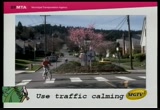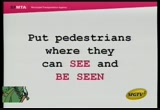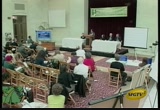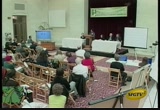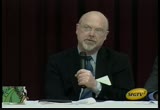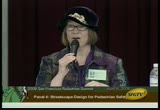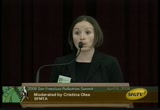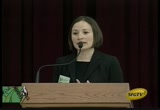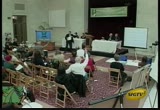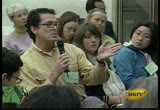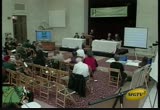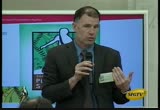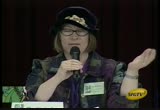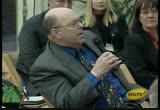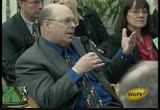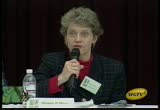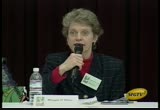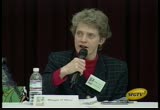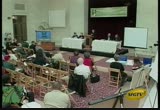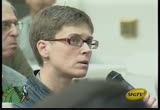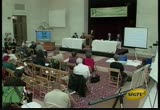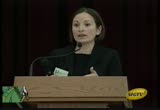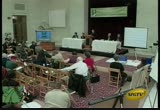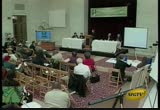tv [untitled] September 1, 2010 5:30pm-6:00pm PST
6:30 pm
and that's a case of people taking the street and saying we have the right to cross, and it's our right under the law and will do that. and a lot of people are doing that for 14 years, and i want to point you to americawalks.org for more resources on the advocacy side. and my job was to be short and tight and now bring you down to the 30 feet level, and one thing that's the most dangerous part of being a pedestrian, and that's crossing a street. and talk about this work i have done on pedestrian design and safety, and i have boiled this down to a formula, and because engineers love formulas. and you should look at the four "s" formule a slow the traffic, slow the crosss and let the
6:31 pm
pedestrian be seen and let the flashing and flow the traffic, we heard that you can do that in a lot of different ways. and the next slide shows traffic calming, but in san francisco i observed you have a lot of signalized streets with one way signal jagz. -- signalization, and you can slow the progression of those streets and in downtown portland we have it at 11 miles per hour, and that's friendly and makes it possible to drive a bike in a lane except if you are on a hill. and second, shorten the
6:32 pm
crossing distance. and we can reassign the road space and next slide, those people are out in the street, and why not give that part of the street to the pedestrians. [applause] and next is let the pedestrian see and be seen, and for that we can use, when we take that space, we make a bulb out or curb extension and you can use that and let the pedestrians be safe and can see the traffic and be seen by people coming at them. and elimination plays a role here, because a lot of people think you want right at the cross walk, infact you want the light to be 25 feet away on either side and that gives what the pedestrians need at the crosswalk. and getting them out to be seen
6:33 pm
and providing elimination. and slash the numbers lanes, and maybe cross the directions to cross. and slashing the number of lanes and using a median refuge, and on a two-way street and you pet a median refuge and get one half one direction. and here in san francisco, and so many signal light turning and the right turning and people on red. and in new york city, they don't have right turn on red, and if i had one change it would be to eliminate right turn on red. that was a big mistake and it encourages people to run red lights, and you can do that
6:34 pm
when you have given the priority to the motorists. and when i was staying there is a left turn trap lane and that sign of hayes has no pedestrian crossing and to go from "a" to "b" and in a nice pedestrian neighborhood, that doesn't make any sense. those are my four rules and i promised to show you the before and after. and this is 122 avenue in portland, and after we applied the measures, now you see the after. and there was a high demand for crossing at that location, and no signalized crosswalk for a mile on one side. and it's been a successful place and there haven't been any incidents here since we put
6:35 pm
it in. and one final design suggestion to show you, and i have to show this everywhere i go, and this was my daughter's idea at 8 years old and her idea, when the signal turns to walk, bars come down. and that would be the ultimate and predictable and safe, just the thought of how we might reorganize the space. and one more time, show the four "s" formula. slow the traffic, shorten the crossing and let the pedestrian be seen and slash the number of directions, and that's all i have now, thanks. [applause] >> thank you ellen, as you can all tell, we have a wealth of knowledge on stage and now is your time to ask questions of
6:36 pm
our panelists. >> i would like to know, what degree of cross discipline fertilization to take place between the planning department and public works department and redevelopment agency in planning a project. and for example, and 6th street cordar -- corridor and when the project was finished, it didn't address the pedestrians of that area. and i would like to make sure that those issues are addressed. and if you can share some information with me how you interface with those agencies, i would deeply appreciate it today. >> that's an interesting question, and i think when we started the better's street program, a year ago, we were pretty green about the difficults of the coordination
6:37 pm
between the different agencies. and in the year or so we have worked on the better streets plans and we are coordinating that work. and you will see that better streets plan is an integrated plan for a number of agencies. and see some idea s that come from that and follow ups of how we as a city can better deliver the streets that we want and that's the best we can offer at this point. >> i was going to have ellen respond as well. do you have any suggestions on coordination, and there are different project leads, how do you pull different projects together, any suggestions from portland? >> from my experience of the portland master plan and the design guidelines, we had 27
6:38 pm
different agencies or groups within our bureaus that had something to do with a particular element of the right-of-way. and because we didn't have a mandated plan and a consensus process, it took three years. and what i used was the water dripping on the stone technique, and you eventually wear your path down. you have to identify who all the players are, and if you can't get anywhere with one person, you go above them. and it takes time but to identify the players and who needs to come along with you, is the key to that. >> i have a follow up question, what tools or devices are in place to make sure that some pivotal points and a
6:39 pm
reevaluation of where you are going and if you get to your destination, in other words, quality assurance. >> there are several check-in's and a lot of times it depends on federal sources and we submit deliverables and go through a review process to be sure that we met our project goals. and there is also in working with different city departments and we have check-in's and check and balances to our projects and key milestone, and i was going to ask manito to give some suggestions. but there is an opportunity to
6:40 pm
check-in and run things past groups and there are a lot of bodies within our departments and you are familiar with ifgot and that's now task, and advisor yy committee and that's an opportunity for check-in and muni has some and spy and capital working group, and those provide opportunities to check in and be sure we are meeting our goals for the project and departments. >> jack, from traffic engineering, redevelopment agency i don't think is here now, but on that sixth street project our office worked with the redevelopment agency and
6:41 pm
the sidewalks were widens and there were corner bulbs and there were proposals for a number of other locations and i was at board of supervisors and we didn't have the votes but they can still be put in. and there are some pedestrian safety improvements and there are a lot more that could be done. but that was a part of the discussion in the design of sixth street improvements. >> i have a street scape design question and it came up this past year and i am surprised on the mta's position, and it relates to the bike plan moving forward. and there is this lawsuit and the bike lanes are prohibited and that's about to clear and we are to hopefully install the bike lanes to complete the connections. and i observed, one small
6:42 pm
block, the block where i live, rather than to put the bike down the middle, and rather remove the automobile lane, the easier thing was to instead remove parking. and actually part of my block has no curb side parking ever. and i don't think if anyone figured there is a negative pedestrian component. and curb side parking provides a buffer for pedestrians and you can step off the curb without getting hit by automobile. and the dynamics and it's easier to impact pedestrians than to impact an automotive lane. and the curb side parking is not existence and it's a narrow sidewalk, and it's used as a loading dock, and the postal carrier parks in the middle and
6:43 pm
no one can get by and when groceries are delivered they park there and taxis and construction, the sidewalk is impassable, and is there a regulation not to remove sidewalk and that's the only way to use that street? >> do you want to see that block? >> this is on scott, between oak and feld, and it used to be parking on both sides and then the city came in and put in turning lanes and they tried to cram so much in this street. and i don't want to limit just to scott, i think it's something that we will see all over the city when the bike
6:44 pm
lanes move forward and past this hiatus, and when you take out parks and you seriously endanger pedestrians and i don't know if you can up something to prevent on the sidewalk, and what would property owners do with construction, and the degree to put construction material. >> let me see if i got your question, and is there a policy as we implement bike lanes and don't take away curb side parking, peter would you take that. >> peter albert, deputy planner at mta, and the bike plan, and it's under injunction, and that means we can't put a bike rack on the sidewalk, and can't build any part until this
6:45 pm
injunction is lifted. and what that has done, we can look at it half empty or say this is what we have to work with and how do we make it work for us. and we are doing the better streets plan and the transit effective plan and the pedestrian program in general and david and christina are working on the better streets plan. and the bike plan is benefiting from all the modes that are being look at. and we are doing something from sf park and it's a strategic and place to look at parking. and we understand that parking as something that's hard to pull away from any block. you never have neighbors say, take my onstreet parking away. and we never hear that. and i think, that the reality as we study the bike plan
6:46 pm
component, this is a huge part, not just because parking as a function the street, and parking is a buffer. and bridget is helping me with the bike plan and doing 56 projects that we will analyze and in that analysis, we will look at the aspect of parking. and there is no hard-and-fast rule that says, biking lane in and parking out. and it's not that simple, and i situation at scott, i live close to that and that's not way we will approach bike lanes as a rule in the city. >> i would like to know how new york city managed to bar right turn on reds.
6:47 pm
and i understand that the fed's have a requirement. and to get back to that. is there any way that another city can get rid of right turns on red? >> someone may know that answer, i don't think they ever allowed right turns on red. and the hold that the fed's have over the states is the money. and that's all i know. someone needs to do research on this. but we have the ability to individually change right turn on red. you are allowed to ban at a given intersection, you start small and work big. >> i red -- read and the fed's and they came into new york and
6:48 pm
they didn't have the requirement of right turn and wanted to know how they did that. >> maybe there is someone here that knows that. >> hi, we were successful in a period of time of five to six years and bringing down the pedestrian facility -- fatality rate and we used many tools. and we haven't done consistently looking at a corridor and a lot of them are major transport and have a high volume of pedestrian crossing. and back on the east coast, they have used it a greater extent white letter crosswalk
6:49 pm
and for the visibility and at dusk we have a higher rate. and why can't we, work as a group and raise the bar on the manual and where we have minimals done in a lot of cities and across the state and traffic engineer public works departments, and use the minimum standard and because of the fear of liability issues instead of raising that bar to the more enhanced crosswalks and in multiuse districts and van ness avenue and those who think they would benefit from bold letter crosswalks in those areas. >> well, change in mtucd is an
6:50 pm
evolutionary process, and don't be fooled, the squeaky wheel gets the grease. this process is not just departments, it's to a large extent it's advocacy and not settling for a second rate status. and to demonstrate with research that what you want is effective. and that's why i initiated the marked crosswalk research and i suspected that drivers didn't understand, when a crosswalk is not marked, it's still a crosswalk. and that's what the study demonstrated and these studies can change to leading the guidance. and if you want to see something changed and there is research to support it, you bring up the research, you just
6:51 pm
keep presing and pressing and maybe one day your grandchildren will see the results. >> there is a request that you explain what the mtcud is. >> it's a bible, it's a traffic control device and when a traffic controller says no, they will point that that manual. and it tells traffic engineers what operational treatments are permissible or required, and it used to say that you had to have so many pedestrians crossing a street before you put in a signal. and that's like waiting to build a bridge and people are swimming across the river. and they are more flexible and the next edition has improvements and they have some
6:52 pm
involving bicyclists. and that's a manual that you need to know about and you can access free online. information is powerful, don't let the engineers -- i will probably be hung for saying this, don't let the engineers have all the power, and you become empowered and to read the stuff yourself and push back and challenge. and i want to say that i had a conversation online with an engineer, and he had mentioned that so-and-so, this one treatment would violate the mutcd, and i said, you know more about that, that's not my specialty, and tell me what sections, and his next e-mail, well, it doesn't violate it. >> and i have a question, it
6:53 pm
will affect two speakers, john paul and maggie, and the safety tools that beat john paul's design and count down signals and pedestrian signals, and one of our challenges with our key corridor and 19th avenue and van ness, that are state highways and getting the state to approve those, are those approved by the state or something that we need to petition on an intersection by intersection basis? >> my speciality is geometric design, i heard a conversation about count down signals, and maybe someone else knows more than me. and that's our operation department, we are very stove pipe, the person that can tell you that is richard hagston at
6:54 pm
headquarters and i believe my e-mail addresses on the hand out, and you just type in richard_ hagston and get in touch with him and he will tell you about the latest and greatest, but it has caught our attention, we were slow on the uptake. >> i had a question about pedestrian bulb outs and having those pictures of kids crossing the intersection and it seems that in san francisco we are schizophrenic about site lines at intersections, and i am pedestrian advocate and a greening advocate. and i know that you can't plant a tree within 25 feet of an
6:55 pm
intersection but you can park a truck at the cross walk line, and it seems those don't compute. and i understand there is a difficulty with parking and that's a political issue. i am willing as a software engineer, i am willing to figure out how to do something than to have it elegant, which is what we do sometimes in software. and i am struck by the fact that there are many intersections where the driveways are close to the crosswalk. and that first parking space isn't what would be a legal parking space and it's four foot or five foot and the people park and block the crosswalk. and i wonder if it's possible to use the ada transition plan such that when a bulb out is
6:56 pm
built on an intersection and the first driveway is 18 feet from the crosswalk and can we not build that out to that first driveway and then the city solves a problem and giving a robust pedestrian space. >> i will answer the first half and bridget will answer the second half. on the red zone at the intersection, that's a policy that we are evaluating as part of the better streets plan. and our proposal is that we have red zones but that we make it 10 feet instead of the recommended 25 feet from the state. and the reason for the shorter red zone, if we stripe 25 feet red, it will get parked in. and we don't have the enforcement for the park ing in
6:57 pm
that red zone, 25 feet would be long enough to accommodate a car. and there wouldn't are enough room for a car to park in that space. and because parking is such a high value in san francisco, that's why we are going with the smaller, it's our compromise, to have a smaller red zone but to provide that space to allow for zone, and her third "s", to allow pedestrians to be seen and vehicles to see pedestrians. >> bridget, did you want to talk about the curb? >> no, i wanted to talk about the right turn on red. and we have done research on that as better streets work and 14% of intersections prohibit
6:58 pm
right turn on red. and if you have locations that are problematic, let us know and you can do that through 311 or let us know today. and how a city goes from a ban on right turn on red. and that's a debate and if people want to see that, it will happen on a policy level and it will have transit effect and there isn't a lot of scientific evidence to support the benefits that outweight the costs. and that's something that today people can think about from a policy level of how to change that. >> okay, we have time for questions. >> and i had a question about bulb outs. as we were saying and a very useful way to increase
6:59 pm
visibility for pedestrians, and i observed that caltran is reluctant to allow the pedestrian to stand out further than the onstreet parking, because it increases liability. and i believe there is an exception on van ness and this is called a mistake by caltran. >> i sorried, i used up all my answer time. i can't comment on a specific project, because i know nothing about it. because we don't have hard guidance in the manual, we allow on an exception basis, and the rule of thumb, you don't want the bulb out to intrude the space for the bicycle, and you don't want the bulb out to go further, you don't want to force the
75 Views
IN COLLECTIONS
SFGTV2: San Francisco Government Television Television Archive
Television Archive  Television Archive News Search Service
Television Archive News Search Service 
Uploaded by TV Archive on

 Live Music Archive
Live Music Archive Librivox Free Audio
Librivox Free Audio Metropolitan Museum
Metropolitan Museum Cleveland Museum of Art
Cleveland Museum of Art Internet Arcade
Internet Arcade Console Living Room
Console Living Room Books to Borrow
Books to Borrow Open Library
Open Library TV News
TV News Understanding 9/11
Understanding 9/11
